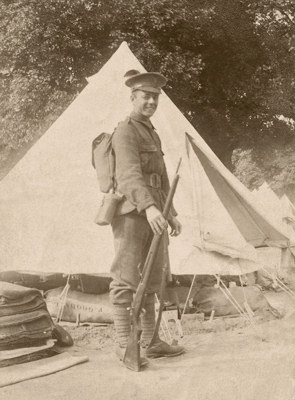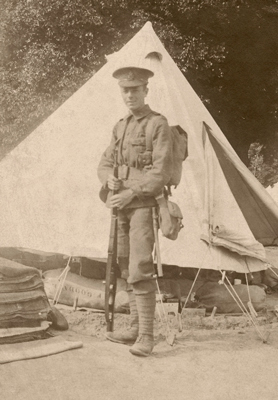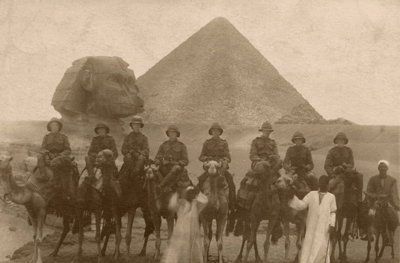Lewis Jones in World War 1
Lewis Jones was a principal artist and fabric designer for the Silver Studio from 1910 to 1953. Lewis Jones fought through the whole of the First World War. He seldom spoke of the war, but occasionally he reminisced to family about places and incidents. For instance, he said the smell of wood smoke always reminded him of Greece.
Lewis Jones (sometimes Louis Jones, usually known as Jack to family and friends) enlisted on 14
th December 1914. He joined the Queen's Westminster Rifles (2/16 London Regiment), which had been formed three months before he joined up. His Regimental Number was initially 3617 and later 551113.

 Lewis Jones at Saffron Walden, 1915
Lewis Jones at Saffron Walden, 1915
The men were issued with old Lee Mitford rifles. The Regiment did training in Richmond Park, Wimbledon Common, and on Salisbury Plain for divisional training. They returned to London and marched to Watford and were in Cassiobury Park when they were provided with horses. They practiced digging trenches in Maidstone. In early 1915 they marched to Saffron Walden, and were under canvass during severe storms and flooding. There were regular raids by Zeppelins.
In the spring of 1916 they expected to go to France but instead they went to Ireland aboard the 'Inniskillin'. They landed at Queenstown and marched to Cork and Limerick. By then Sinn Fein had surrendered and handed over their modern German rifles. The Easter 1916 Rebellion in Dublin was over and the Regiment returned to England, and they were inspected by King George V at Warminster. Louis did not speak kindly of the Irish.
In June 1916 the Regiment went from Southampton to Le Havre on the 'Connaught' and 'St Pancras' transport ships, then by train to Petit Lourin [Horin], west of Arras. There was horrid confusion and mud, and the sky was bright from the "nightly display" of gunfire from about 20 miles away. The weather was stormy and they were drenched as they marched to the front. Finally they got to [Ecroves] Bois de Bray and "The Territorial" which was a communication trench from Zivy to Mareail [Mareenil] and the "Support Line".
The Regiment moved into the front line trenches with Vimy Ridge to the left and Thélus to the front. Here they were constantly straffed by "Minny" (or "Minnie", the German minenwerfer trench mortars), so asked the artillery to fire on the spot where Minnie lived. The first Military Cross for an officer of the Battalion was gained here, but he was killed a few days later. On 24
th October 1916 they handed over to the Canadians.
The Regiment was told it was now part of the British Salonica Force (BSF). After extensive training they went by train to Marseilles and boarded 'HMT Transylvania'. In luxurious conditions and with glorious weather they sailed to Valetta in Malta where they waved to all the civilians on the liner 'Carnac' which was departing. The liner was torpedoed a few days later by a U-boat with great loss of life.
Their troopship safely reached the Gulf of Salonica at the end of November 1916. Here they learned that an assault landing was planned. They used the lighters that had been in the landings in Gallipoli and which still had bullet and shrapnel damage. The landing was made at Vromeri Beach and was unopposed. The Regiment then marched to Katerini to meet the transport section which had gone overland with 27 mules. The transport section with all the supplies had been unable to beach their lighters because of severe storms. The supplies arrived safely despite the unbroken mules and men unaccustomed to working them. One night the mules broke loose but were all rounded up. Lewis said he had no trouble with the "donkeys", probably because he could handle 'Nobbler' his father's unbroken stallion.
One day a German plane flew over and they fired with rifles and Lewis guns. It was shot down by "Archies" (anti aircraft guns). According to the Adjutant's book: for a while they passed the time with sports, and the officers went shooting; then news came that the Greeks had joined the Allies, and there were lamentations on leaving Katerini because they had been happy there.
In March 1917 they marched about 100 miles to the Dojran-Vardar front through the Vardar Marshes. Lewis said that during this long march they bought sheep bells from Greek farmers which they rang as they marched and they sang "The bells of hell go ding-a-ling-a-ling for you but not for me..." On the march the Russian troops who were with them started to fight each other when they heard of the 'Revolution'.
They waited to enter Karasouli after dark because previous units had been shelled there. There was a severe storm and flooding so that the next day they went in single file with water up to the knees. Stores were lost and it snowed.
After arriving at the front they took casualties from the Bulgarian artillery. Trenches were often only 18 inches deep. A pencil note by a previous reader in Adjutant Mare's book reads "none at all at times". They were not trained for open warfare and the constant shelling and unexploded shells "put the fear of gas in us" - gas shells and unexploded shells apparently landing with a similar sound. They were then withdrawn to Salonica. In the Balkans the Regiment had taken as many casualties as they had in France.
At Salonica they boarded 'HMT Manitou' and sailed for Egypt. They docked at Alexandria and went by train to Ishmailia, where Lewis was able to bathe in the Bitter Lake. Officers and NCOs were given leave in Cairo and Lewis rode a camel at the Pyramids.
The Regiment marched to Kantara (Al Qantarah El Sharqiyya) in North East Egypt, and the front line, to oppose the Turkish army. Outposts were manned by two in daytime, and one day Lewis Jones was wounded in the head and his comrade killed by a sniper. The comrade had shouted "Joner the tree!" before being killed. Nomadic Arabs found him, dressed his wounds and told him that he had shot and killed the sniper who had wounded him. During the time he was with the Arabs his parents received a 'Missing believed killed' telegram. He travelled with the Arabs until they were able to make contact with the British troops. On his return to the army he was sent to a military hospital, but he feared the chaotic conditions there so he simply walked out and rejoined his unit.
Adjutant Mare's book* ends here and in the National Army Museum library's copy is a handwritten note: "Shortly after this the writer was wounded and left for base and later to London where he contracted influenza and died".



